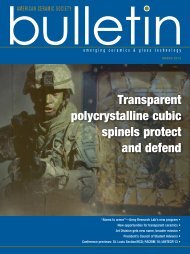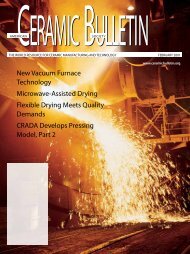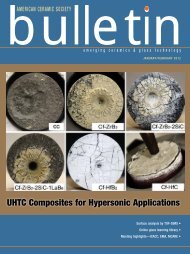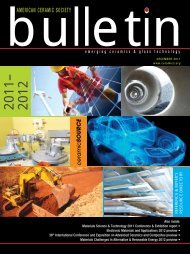American Ceramic Society Bulletin
American Ceramic Society Bulletin
American Ceramic Society Bulletin
Create successful ePaper yourself
Turn your PDF publications into a flip-book with our unique Google optimized e-Paper software.
Topological constraint theory of glass<br />
Fig. 7. (a) Traditional Phillips–Thorpe constraint theory<br />
with a single rigidity percolation threshold separating<br />
floppy and rigid compositions. (b) According<br />
to Boolchand’s results, the rigidity percolation<br />
threshold is really two thresholds yielding an intermediate<br />
phase of finite width between the floppy<br />
and stressed rigid phases. The intermediate phase<br />
corresponds to a range of compositions that can<br />
self-assemble in optimally constrained (i.e., isostatic)<br />
configurations. Beyond a certain limit, additional<br />
constraints cannot be accommodated by changes in<br />
clustering or intermediate-range order, and then the<br />
system enters a stressed rigid phase.<br />
has been extended by Micoulaut and<br />
Phillips 43–47 to consider various configurations<br />
of clusters within a glass. In the<br />
Micoulaut–Phillips approach, clusters<br />
are constructed of increasing size, the<br />
probability of each cluster depending<br />
on the energy associated with the<br />
elementary units.<br />
The more favorable configurations<br />
are those leading to an isostatic condition,<br />
which gives an overall lower free<br />
energy of the system. This self-organization<br />
of various cluster configurations<br />
enables the intermediate-range ordering<br />
necessary to produce the intermediate<br />
phase. The optimized configurations of<br />
the glass within the intermediate phase<br />
also mean there is less driving force<br />
for relaxation and, hence, a minimum<br />
in nonreversing heat flow. The stressfree<br />
nature also has been shown from<br />
Raman pressure experiments. 48<br />
The discovery of the intermediate<br />
phase has not been without controversy.<br />
In particular, Simon 49,50 has<br />
shown that the integration of the nonreversing<br />
heat flow from MDSC does<br />
not correspond exactly to the enthalpy<br />
of aging through the glass transition.<br />
Subsequent work by Carpentier et al. 51<br />
has provided a thorough analysis of<br />
relaxation using MDSC.<br />
Also, currently, there is no clear evidence<br />
from NMR 31 or neutron diffrac-<br />
Fig. 8. Observed reversibility windows from modulated DSC experiments<br />
for various glass systems. The reversibility window corresponds<br />
to the intermediate-phase compositions, here shown as a<br />
function of average coordinate number. Window centroids in group<br />
IV selenides are at ‹r› > 2.40, whereas group V selenides are at ‹r›<br />
< 2.40. Ternary alloys encompass both regions of ‹r› space. Special<br />
thanks to P. Boolchand for providing this figure.<br />
tion 52 data to<br />
discern the<br />
structural<br />
signatures<br />
of the intermediate<br />
phase. For example, recent<br />
NMR measurements of Lucas 53 have<br />
led to a proposed model of germaniumselenium<br />
glass structure composed of<br />
selenium-rich (flexible) and GeSe 2 -rich<br />
(stressed rigid) nanophases in which no<br />
intermediate phase would be possible.<br />
Nevertheless, Micoulaut and Malki 54<br />
have shown direct evidence for a characteristic<br />
dynamical length scale associated<br />
with the intermediate phase in<br />
fast-ion-conducting glasses.<br />
In the current author’s opinion, the<br />
existence of such controversy serves as<br />
great evidence for the amount of exciting<br />
research that is yet to be done in this<br />
area. No matter what the final outcome,<br />
we are sure to learn much along the way<br />
to further our understanding of the glassy<br />
state in terms of structure and properties.<br />
Conclusions and further reading<br />
Topological constraint theory is<br />
arguably the most powerful tool available<br />
today to predict the relationship<br />
between the composition and structure<br />
of a glass and its measurable properties.<br />
Because constraint theory focuses<br />
on the key physics that governs the<br />
glassy state, viz., the network of bond<br />
constraints, it effectively bypasses the<br />
limitations associated with traditional<br />
atomistic modeling techniques, such as<br />
molecular dynamics. However, there<br />
remains much work to be done regarding<br />
the theoretical and applied aspects<br />
of constraint theory, such as the extension<br />
to new compositions and properties<br />
of interest. One cannot help but<br />
be excited by the future prospects of<br />
this approach, which is poised to make<br />
the computational design of new glassy<br />
materials a reality.<br />
Readers interested in learning more<br />
about constraint theory are encouraged<br />
to check out the new book, Rigidity<br />
and Boolchand Intermediate Phases in<br />
Nanomaterials, edited by Micoulaut and<br />
Popescu. 55 It provides an excellent overview<br />
of recent advances in constraint<br />
theory, including generous doses of<br />
experimental and modeling work. This<br />
book is a celebration of the constraint<br />
theory approach to glass science, following<br />
the original work of Phillips and<br />
Thorpe, and of the exciting theoretical<br />
and experimental work that has been<br />
published in the ensuing decades. The<br />
36 <strong>American</strong> <strong>Ceramic</strong> <strong>Society</strong> <strong>Bulletin</strong>, Vol. 90, No. 4






